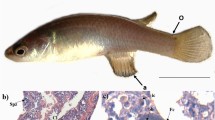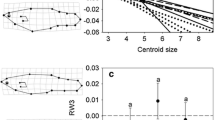Synopsis
Breeding compexes of poeciliid fishes with a bisexual and two unisexual species were studied for mechanisms permitting Sympatric coexistence. The unisexuals are gynogenetic and thereby sexually dependent on the males of the bisexual species for sperm to initiate development, but inheritance is entirely maternal.
Bisexual females are more abundant in headwater localities; unisexuals increase in downstream localities. Males were 10 – 18% of the total poeciliid population, regardless of the relative proportions of bisexual to unisexual females. Downstream localities were typified by greater habitat diversity, including a variety of backwater pools. The unisexuals showed a marked preference for such pools. Both field and laboratory studies showed that all three types of females as well as males preferred shaded areas with a gravel substrate.
Although the four types of fish were found together, nearest neighbour data indicated that each type of female preferred its own kind. Males courted throughout the year and were indiscriminate in their choice of mates. Despite the skewed sex ratio, males were not in short supply because only a few females were sexually receptive at a given time. No significant differences existed between bisexuals and unisexuals in their relative reproductive outputs, but they were asynchronous.
Similar content being viewed by others
References cited
Balsano, J.S., R.M. Darnell & P. Abramoff. 1972. Electrophoretic evidence of triploidy associated with populations of the gynogenetic teleostPoecilia formosa. Copeia 1972: 292–297.
Hardin, G. 1960. The competitive exclusion principle. Science 131: 1292–1297.
Hutchinson, G.E. 1965. The ecological theatre and the evolutionary play. Yale Univ. Press, New Haven. 139 pp.
Hubbs, C. 1964. Interactions between a bisexual fish species and its gynogenetic sexual parasite. Bull. Texas Mem. Mus. 8: 1–72.
Kucharski, K. 1979. Habitat preferences and associations of a unisexual-bisexual complex ofPoecilia (Pisces: Poeciliidae) from northeastern Mexico. M.Sc. thesis, Florida Atlantic University, Boca Raton. 77 pp.
McKay, F.E. 1970. Behavioral aspects of population dynamics in unisexual-bisexualPoeciliopsis (Pisces: Poeciliidae). Ph.D. thesis, Univ. Connecticut, New Haven, 92 pp.
McKay, F.E. 1971. Behavioral aspects of population dynamics in unisexual-bisexualPoeciliopsis (Pisces: Poeciliidae). Ecol. 52: 778–798.
Moore, W. 1976. Components of fitness in the unisexual fishPoeciliopsis monacha-occidentalis. Evol. 30: 564–578.
Moore, W. & F.E. McKay. 1971. Coexistence in the unisexualbisexual species complexes ofPoeciliopsis (Pisces: Poeciliidae). Ecol. 52: 791–799.
Monaco, P.J., E.M. Rasch & J.S. Balsano. 1978. Cytological evidence for temporal differences during the asynchronous ovarian maturation of bisexual and unisexual fishes of the genusPoecilia. J. Fish Biol. 13: 33–44.
Monaco, P.J., E.M. Rasch & J.S. Balsano. 1981. Sperm availability in naturally occurring bisexual-unisexual breeding complexes involvingPoecilia mexicana and the gynogenetic teleost,Poecilia formosa. Env. Biol. Fish. 6 (in print).
Rasch, E.M. & J.S. Balsano. 1974. Biochemical and cytogenetic studies ofPoecilia from eastern Mexico. II. Frequency, perpetuation, and probable origin of triploid genomes in females associated withPoecilia formosa. Rev. Biol. Trop. 21: 351–381.
Author information
Authors and Affiliations
Rights and permissions
About this article
Cite this article
Balsano, J.S., Kucharski, K., Randle, E.J. et al. Reduction of competition between bisexual and unisexual females ofPoecilia in northeastern Mexico. Environ Biol Fish 6, 39–48 (1981). https://doi.org/10.1007/BF00001798
Received:
Accepted:
Issue Date:
DOI: https://doi.org/10.1007/BF00001798




